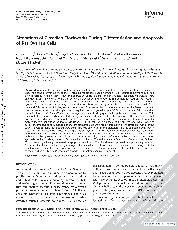摘要
Ovarian development is related to cell proliferation, differentiation, and apoptosis of granulosa cells and luteal cells under the control of various modulators, including follicle-stimulating hormone (FSH), luteinizing hormone (LH), and growth factors. In the present study, the expression of clock genes and the related regulation mechanism were analyzed in different ovarian cell types during differentiation and apoptosis. The authors focused on the circadian expression of Per2 as a core clock gene for the maintenance of circadian rhythms. By using a real-time monitoring system of the Per2 promoter activity, the circadian oscillation was analyzed in the granulosa and luteal cells from preantral follicles, antral follicles, and corpora lutea of immature Per2 promoter-destabilized luciferase transgenic rats that were primed with diethylstilbestrol, equine chorionic gonadotropin (eCG), and/or human CG. In addition, transcript levels of Per2, Bmal1, Clock, and Nampt were quantified by quantitative polymerase chain reaction (qPCR). Immunohistochemical studies revealed strong circadian rhythmicity of PER2 protein in the luteal cells, but apparently little rhythmicity in granulosa cells of both preantral and antral follicles. In vitro monitoring of promoter activity showed generation of several oscillations in luteal cells after exposure to dexamethasone (DXM), whereas oscillatory amplitudes of immature and mature granulosa cells were rapidly attenuating. The circadian rhythm of the Bmal1 transcript levels, but not the Per2 transcript, was very weak in the granulosa cells, as compared with that in luteal cells. Granulosa cells gained a strong circadian rhythm ability of the Per2 promoter activity after stimulation with FSH for 3 days. In contrast, LH had little effect on the circadian rhythm before stimulation of granulosa cells with FSH, probably owing to lack of LH receptor. In luteal cells, induction of apoptosis by inhibiting progesterone synthesis resulted in deregulation of Per2 circadian oscillation. Transcript levels of Bmal1 and Clock, but not Per2 and Nampt, were significantly decreased in apoptotic luteal cells. The Bmal1 transcript level was particularly reduced. Consequently, these results strongly suggest the circadian clockwork alters in ovarian cells during follicular development, luteinization, and apoptosis, and expression of Bmal1 may be related to the switch-on and switch-off of the circadian oscillation. (Author correspondence: mhattori@agr.kyushu-u.ac.jp)
- 出版日期2011
- 单位浙江大学
